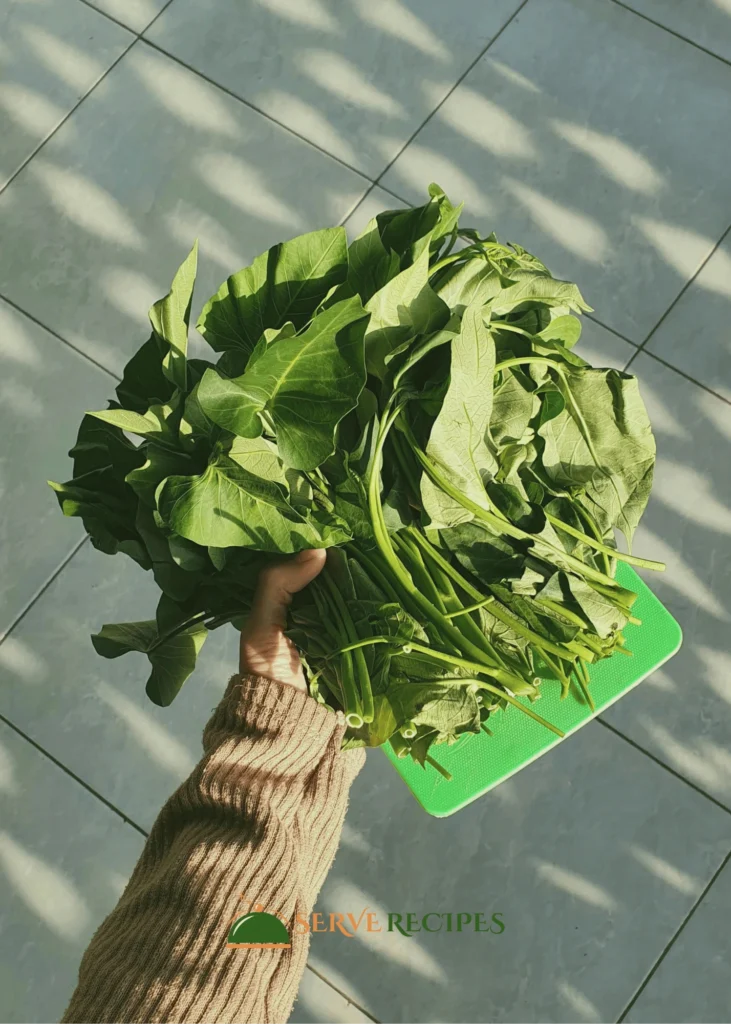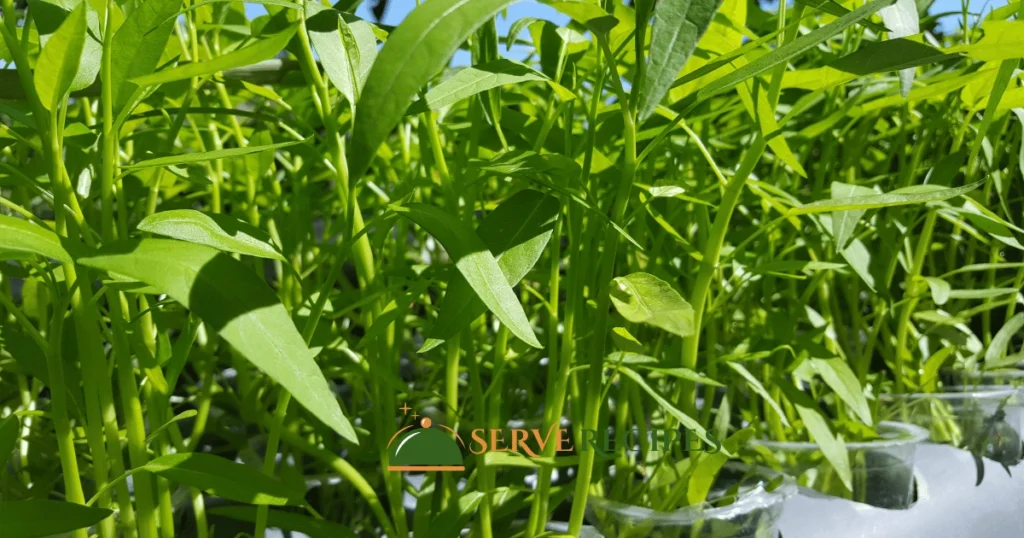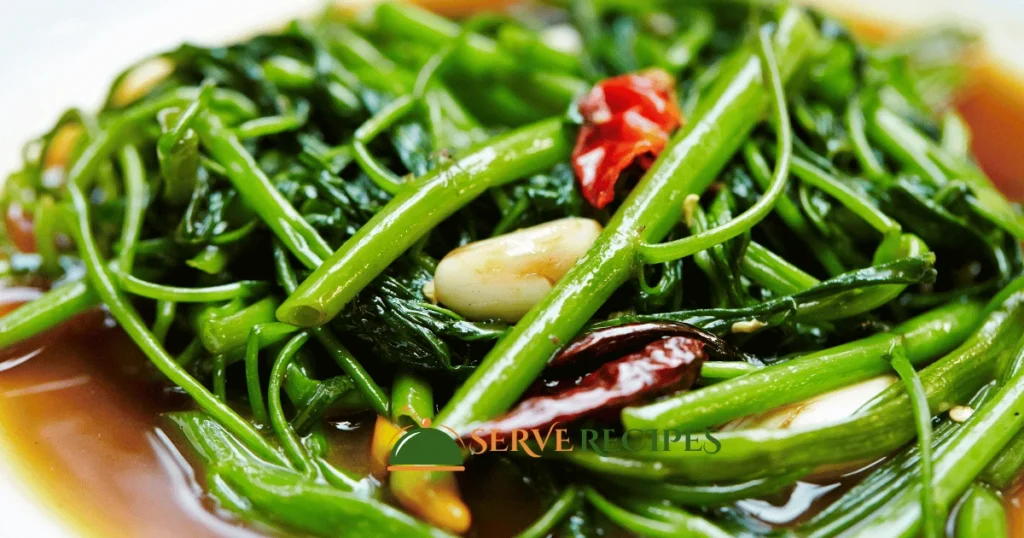You’ve probably come across Kangkong in a recipe or seen it in a local market and wondered, “What is this vegetable called in English?” The answer to this seemingly simple question is more complex than you might expect. A famous leafy green in Southeast Asia, Kangkong is frequently used in salads, soups, and stir-fries. However, if you’re unfamiliar with it, the English name might take time to clear.

In this article, we’re diving deep into what Kangkong is, what it’s called in English, and why it’s becoming increasingly prevalent worldwide. If you love discovering new foods that offer both flavor and nutrition, Kangkong might be your next go-to ingredient. So, let’s explore this unique vegetable, its versatility, and its global significance.
Table of Contents
Kangkong Vegetable in English
Kangkong, scientifically known as Ipomoea aquatica, is commonly referred to as water spinach or swamp cabbage in English. This aquatic vegetable thrives in wet, marshy conditions and is often found near riverbanks or in flooded areas. Kangkong’s popularity in Southeast Asian cuisine is undeniable, but its English name might vary depending on the region. Here are the most common names it’s known by in English-speaking countries:
- Water Spinach: This is the most widely recognized English name for Kangkong. It’s often used because of the plant’s habitat in or near water, as well as its similarity to traditional spinach in taste and texture.
- Swamp Cabbage: Another name used, particularly in areas where the vegetable is cultivated in swampy regions. The term emphasizes the vegetable’s growing conditions.
- River Spinach: This name is sometimes used due to the vegetable’s tendency to thrive in river environments.

While these names might sound interchangeable, it’s important to note that water spinach is the most widely accepted term in English.
The Nutritional Powerhouse: Why You Should Add Kangkong to Your Diet
When you think of leafy greens, you probably think of nutritious options like spinach or kale. But have you considered adding Kangkong to your diet? Not only is this vegetable incredibly versatile in cooking but it’s also packed with health benefits.
Key Nutritional Benefits of Kangkong:
- Rich in Vitamins: Kangkong is loaded with essential vitamins such as Vitamin A, Vitamin C, and several B vitamins. These vitamins play a crucial role in maintaining healthy skin, boosting the immune system, and supporting overall bodily functions.
- High in Antioxidants: The vegetable contains powerful antioxidants that help fight off harmful free radicals, promoting a healthy heart and reducing the risk of chronic diseases.
- Packed with Minerals: It’s a good source of essential minerals like iron, calcium, and potassium. These minerals help maintain healthy bones, regulate blood pressure, and prevent anemia.
- Low in Calories: Kangkong is low in calories, making it an excellent option for those looking to maintain or lose weight. It provides fiber and nutrients without contributing excess calories.
For additional health benefits and nutrition facts, take a look at these 7 Amazing Health Benefits of Kangkong.
Why Kangkong is a Superfood:
Kangkong is not just another leafy green; it’s a superfood that can boost your overall health. It can be consumed raw in salads, sautéed, or included in soups and stews. By adding Kangkong to your meals, you’re taking a step toward better health with minimal effort.
How Kangkong is Used in Global Cuisines
Kangkong may be most closely associated with Southeast Asian cuisine, but this leafy green has made its way into various culinary traditions worldwide. Whether in savory dishes, soups, or even smoothies, this vegetable offers incredible versatility.

Common Ways to Cook Kangkong:
- Stir-Fried Kangkong: One of the most popular ways to enjoy Kangkong is by stir-frying it with garlic, chilies, soy sauce, and oyster sauce. This dish is a staple in many Southeast Asian households.
- Kangkong Soup: Known for its soothing properties, Kangkong is often added to soups. It pairs beautifully with other vegetables or meats, providing a nutritious addition to your bowl.
- Kangkong Salad: In some regions, Kangkong is eaten raw in salads. It is a pleasant complement to any cuisine because of its mild, somewhat sweet flavor.
- Curries and Stews: In Thai and Indian cuisines, Kangkong is commonly added to rich, flavorful curries or stews. It absorbs the spices well, adding a nutritious dimension to the dish.
- Smoothies and Juices: Health-conscious individuals also blend Kangkong into smoothies and juices, appreciating its detoxifying properties.
Regional Dishes Featuring Kangkong:
- Philippines: In Filipino cuisine, Kangkong is often featured in sinigang (a sour soup) or adobong Kangkong (water spinach cooked in soy sauce, vinegar, garlic, and bay leaves).
- Vietnam: Known as rau muống, Kangkong is commonly used in stir-fried dishes or soups, often served with fish sauce and garlic.
- Thailand: Thai cuisine often includes Kangkong in pad pak boong (stir-fried water spinach with garlic and chili) or as an ingredient in curries.
Health Benefits of Kangkong and Its Role in Traditional Medicine
Kangkong is not only loved for its taste, but it also plays a vital role in traditional medicine. It’s believed to have several healing properties, especially in Southeast Asia, where it’s been used for centuries.
Traditional Health Benefits of Kangkong:
- Detoxification: Kangkong is often considered a natural detoxifier, helping cleanse the liver and kidneys.
- Anti-Inflammatory Properties: The vegetable contains compounds that may help reduce inflammation, making it beneficial for individuals suffering from conditions like arthritis.
- Digestive Health: Kangkong’s high fiber content aids in digestion and can help alleviate constipation.
- Blood Sugar Regulation: Some studies suggest that Kangkong may help regulate blood sugar levels, making it a good food choice for people with diabetes.
Kangkong in Folk Medicine:
In some parts of Asia, Kangkong is used in folk medicine to treat conditions such as fever, high blood pressure, and respiratory issues. While more research is needed to substantiate these claims, its role in traditional healing must be addressed.
Growing and Harvesting Kangkong
If you’re inspired to grow Kangkong in your garden, you’ll be pleased to know that it’s relatively easy to cultivate. Here’s what you need to know about growing Kangkong at home.
Tips for Growing Kangkong:
- Water Requirements: Kangkong thrives in wet, marshy soil, so make sure it’s planted in an area that stays consistently moist. It’s often grown in flooded beds or near bodies of water.
- Light Requirements: The plant does well in full sunlight, although it can tolerate partial shade.
- Soil: Kangkong grows best in nutrient-rich, well-drained soil. A blend of compost and organic matter can be used to enrich the soil.
- Harvesting: You can start harvesting Kangkong after a few weeks of growth. Cut the leaves and stems, leaving the roots and base to continue growing. It’s a highly productive plant that will continue to yield new growth.
Where to Buy Kangkong and How to Store It
You might be wondering, “Where can I find Kangkong?” or “How should I store it once I bring it home?” Here’s everything you need to know.
Buying Kangkong:
- Local Markets: If you live in an area with a large Southeast Asian or multicultural community, you might find Kangkong in local markets or Asian grocery stores.
- Farmers’ Markets: In some regions, especially near bodies of water or in tropical climates, farmers may sell Kangkong at local markets.
- Online: You can also find fresh or frozen Kangkong on online marketplaces, depending on where you live.
Storing Kangkong:
- Refrigeration: Keep Kangkong in a plastic bag or container in the fridge to preserve its freshness. It typically lasts about 3 to 4 days.
- Freezing: If you can’t use it all at once, you can blanch Kangkong and freeze it for later use.
Conclusion: Embrace the Flavor and Nutrition of Kangkong
Now that you know what Kangkong is called in English and how to use it in your meals, it’s time to explore this fantastic vegetable for yourself. Whether you’re looking for a nutritious addition to your meals, a new ingredient to experiment with, or simply a way to boost your health, Kangkong has something to offer. So why not give it a try? Your taste buds—and your body—will thank you!